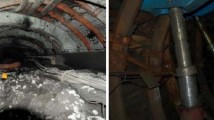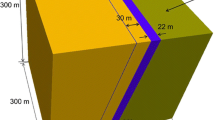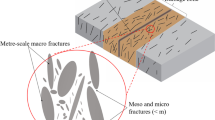Abstract
Seismic events can take place due to the interaction of stress waves induced by stope production blasts with faults located in close proximity to stopes. The occurrence of such seismic events needs to be controlled to ensure the safety of the mine operators and the underground mine workings. This paper presents the results of a dynamic numerical modelling study of fault slip induced by stress waves resulting from stope production blasts. First, the calibration of a numerical model having a single blast hole is performed using a charge weight scaling law to determine blast pressure and damping coefficient of the rockmass. Subsequently, a numerical model of a typical Canadian metal mine encompassing a fault parallel to a tabular ore deposit is constructed, and the simulation of stope extraction sequence is carried out with static analyses until the fault exhibits slip burst conditions. At that point, the dynamic analysis begins by applying the calibrated blast pressure to the stope wall in the form of velocities generated by the blast holes. It is shown from the results obtained from the dynamic analysis that the stress waves reflected on the fault create a drop of normal stresses acting on the fault, which produces a reduction in shear stresses while resulting in fault slip. The influence of blast sequences on the behaviour of the fault is also examined assuming several types of blast sequences. Comparison of the blast sequence simulation results indicates that performing simultaneous blasts symmetrically induces the same level of seismic events as separate blasts, although seismic energy is more rapidly released when blasts are performed symmetrically. On the other hand when nine blast holes are blasted simultaneously, a large seismic event is induced, compared to the other two blasts. It is concluded that the separate blasts might be employed under the adopted geological conditions. The developed methodology and procedure to arrive at an ideal blast sequence can be applied to other mines where faults are found in the vicinity of stopes.
























Similar content being viewed by others
References
Alber M, Fritschen R, Bischoff M, Meier T (2009) Rock mechanical investigations of seismic events in a deep longwall coal mine. Int J Rock Mech Min Sci 46:408–420
Arjang B (1991) Pre-mining stresses at some hard rock mines in the Canadian Shield. CIM Bull 84(946):80–86
Arjang B, Herget G (1997) In situ ground stresses in the Canadian Hardrock Mines: an update. Int J Rock Mech Min Sci Geomech Abstr 34
Barton N, Choubey V (1977) The shear strength of rock joints in theory and practice. Rock Mech 10:1–54
Bewick RP, Valley B, Runnals S, Whitney J, Krynicki Y (2009) Global approach to managing deep mining hazard. In: The 3rd CANUS rock mechanics symposium, Toronto, 2009
Bieniawski ZT (1976) Rock mass classification in rock engineering. In: Exploration for rock engineering, Balkema, Cape Town
Blake W, Hedley DGF (2003) Rockbursts case studies from North America hard-rock mines. In: Society for mining, metallurgy, and exploration, Littleton, Colorado, USA
Brady BHG, Brown ET (1993) Rock mechanics: for underground mining. Chapman & Hall, London
Brinkmann JR (1987) Separating shock wave and gas expansion breakage mechanism. Paper presented at the 2nd international symposium rock fragmentation by blasting
Cai M, Kaiser PK, Martin CD (2001) Quantification of rock mass damage in underground excavations from microseismic event monitoring. Int J Rock Mech Min Sci 38:1135–1145
Castro LAM, Carter TG, Lightfoot N Investigating factors influencing fault-slip in seismically active structures. In: 3rd CANUS rock mechanics symposium, Toronto, 2009
Chen SG, Zhao J (1998) A study of UDEC modelling for Blast wave propagation in jointed rock masses. Int J Rock Mech Min Sci 35(1):93–99
Company AP (1987) Explosives and Rock Blasting
Daehnke A (1997) Stress wave and fracture propagation in rock, Vienna University of Technology
Diederichs MS (1999) Instability of hard rock mass: the role of tensile damage and relaxation. University of Waterloo, Waterloo
Domanski B, Gibowicz SJ (2008) Comparison of source parameters estimated in the frequency and time domains for seismic events at the Rudna copper mine, Poland. Acta Geophys 56(2):324–343
Hedley DGF (1992) Rockburst handbook for ontario hard rock mines. Minister of supply and services, Canada
Henning J (1998) Ground control strategies at the bousquet 2 mine. McGill University, Montreal
Henning J, Mitri HS (2010) Production blast-induced vibrations in longhole open stoping—a case study. Int J Geotech Earthq Eng 1(2):1–11
Hofmann GF, Scheepers LJ (2011) Simulating fault slip areas of mining induced seismic tremors using static boundary element numerical modelling. Min Technol 120(1):53–64
Holmberg R, Persson PA (1979) Design of tunnel perimeter blast hole patterns to prevent rock damage. Paper presented at the Tunnelling ‘79, London
Itasca (2009) FLAC3D—fast Lagrangian analysis of continua, 4.0th edn. Itasca Consulting Group Inc., USA
Ivins ER, Lyzenga GA (1986) Stress patterns in an interplane shear zone: an effective anisotropic model and implications for the transverse ranges, California. Philos Trans R Soc A 318:285–347
Jiang JJ, Blair DP, Baird GR (1995) Dynamic response of an elastic and viscoelastic full-space to a spherical source. Int J Numer Anal Met Geomech 19:181–193
Kexin D (1995) Maintenance of roadways in soft rock by roadway-rib destress blasting. China Coal Soc 20(3):311–316
Li J, Ma G, Huang X (2010) Analysis of wave propagation through a filled rock joint. Rock Mech Rock Eng 43:789–798
Lysmer J, Kuhlemeyer RL (1969) Finite dynamic model for infinite media. J Eng Mech 95(EM4):859–877
Mosinets VN, Garbacheva NP (1972) A seismological method of determining the parameters of the zones of deformation of rock by blasting. Sov Min Sci 8(6):640–647
Ortlepp WD (2000) Observation of mining-induced faults in an intact rock mass at depth. Int J Rock Mech Min Sci 37:423–426
Persson PA, Holmberg R, Lee J (1994) Rock blasting and explosives engineering. CRC Press Inc., Boca Raton
Potvin Y, Jarufe J, Wesseloo J (2010) Interpretation of seismic data and numerical modelling of fault reactivation at El Teniente, Reservas Norte sector. Min Technol 119(3):175–181
Saharan MR (2004) Dynamic modelling of rock fracturing by destress blasting. McGill University, Montreal
Sainoki A, Mitri HS (2014) Dynamic modelling of fault slip with Barton’s shear strength model. Int J Rock Mech Min Sci 67:155–163. doi:10.1016/j.ijrmms.2013.12.023
Sartor T (1999) Modelling vibration induced damage from blasting at the Cannington Mine. The University of Queensland, Brisbane
Sharafisafa M, Mortazavi A (2011) Numerical analysis of the effect of a fault on blast-induced wave propagation. Paper presented at the 45th US rock mechanics/geomechanics symposium, San Francisco, California
Sharpe JA (1942) The production of elastic waves by explosion pressure. Geophysics 7(2):144–154
Snelling PE, Godin L, McKinnon SD (2013) The role of geologic structure and stress in triggering remote seismicity in Creighton Mine, Sudbury, Canada. Int J Rock Mech Min Sci 58:166–179
van Gool B (2007) Effects of blasting on the stability of paste fill stopes at Cannington Mine, James Cook University
White BG, Whyatt JK (1999) Role of fault slip on mechanisms of rock burst damage, Lucky Friday Mine, Idaho, USA. Paper presented at the 2nd Southern African rock engineering symposium. Implementing rock engineering knowledge, Johannesburg, South Africa
Yang RL, Rocque P, Katsabanis P, Bawden WF (1994) Measurement and analysis of near-field blast vibration and damage. Geotech Geol Eng 12:169–182
Zhang Y, Mitri H (2008) Elastoplastic stability analysis of mine haulage drift in the vicinity of mined stopes. Int J Rock Mech Min Sci 45:574–593
Acknowledgments
This work is financially supported by an NSERC Discovery Grant and McGill University (MEDA Program); the authors are grateful for their support.
Author information
Authors and Affiliations
Corresponding author
Rights and permissions
About this article
Cite this article
Sainoki, A., Mitri, H.S. Dynamic Modelling of Fault Slip Induced by Stress Waves due to Stope Production Blasts. Rock Mech Rock Eng 49, 165–181 (2016). https://doi.org/10.1007/s00603-015-0721-2
Received:
Accepted:
Published:
Issue Date:
DOI: https://doi.org/10.1007/s00603-015-0721-2




